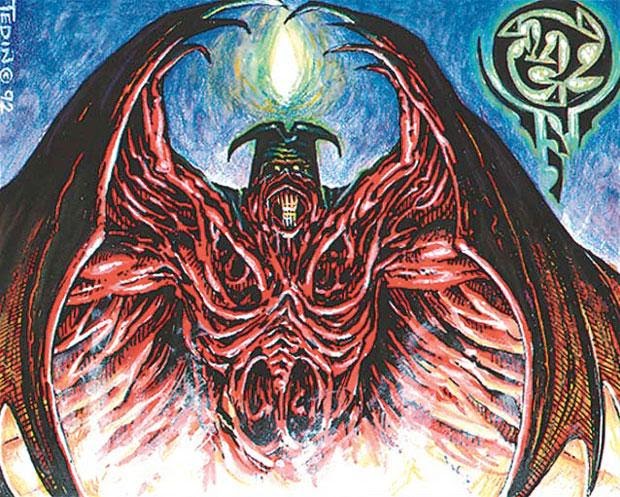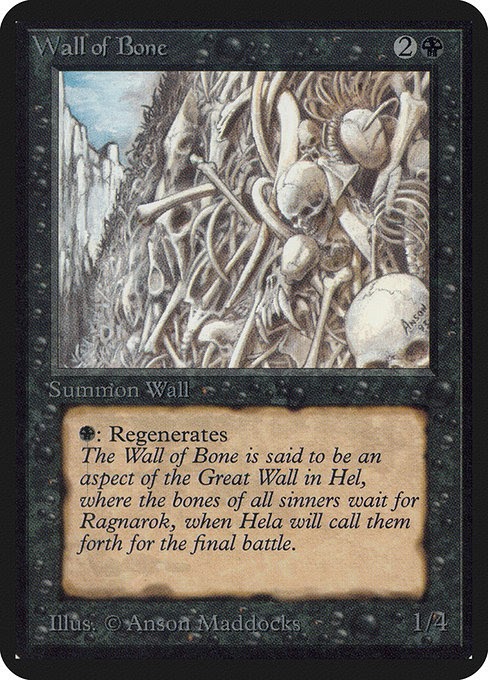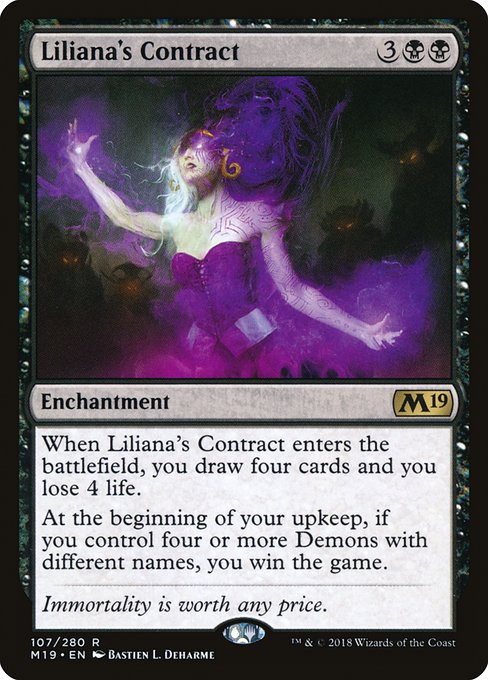As Halloween approached in the autumn of 1994, in the golden light of morning pouring through dusty school bus windows, I caught my first glimpse of Magic: the Gathering cards. As a slight, geeky 11-year-old kid who loved anything in the fantasy genre, I was immediately transfixed. The backs of the cards conjured to mind a grimoire of long forgotten arcana; and the card fronts, with flavorful frames and art depicting fantastic creatures, artifacts, and spells, enraptured me such that cards like Shivan Dragon, Raise Dead, and Brass Man were all I could think about. I hadn’t the foggiest idea how the game was played and owned no cards myself. Yet even divorced from the context of play, the cards had the capacity to build worlds in my friends’ minds and my own. Indeed, the booster packs themselves invited us to “visit the shores of imagination!”
How they did this was a question on our parents’ minds, however. The 1980s saw the beginning of “the Satanic Panic,” and even throughout the 1990s, God-fearing Christian parents were wary of depictions evoking magic, demons, or anything that could be seen as a gateway to the occult. Dungeons and Dragons had been at the center of a national moral panic over supposed Satanic ritual abuse, and Magic: the Gathering was only a few years behind it with similar imagery. Were there, as two women in Bedford New York argued, the “signs and rites of at least 30 satanic cults” functioning as “inducements […] to engage in destructive, cruel cult practices” in Magic? I remember my seventh-grade shop teacher becoming suspicious and questioning me when I incorporated the set symbols of Arabian Nights and Antiquities and the Magic logo into a wood burning project. “What does this mean?” he asks with eyebrow raised. Good question, Mr. Cotter.
In this essay, I’m delving into Magic’s early use of demonic imagery and insinuations of witchcraft to establish black’s flavor and function—a flavor that persisted and continues even beyond the removal of the real-world imagery that helped establish the color’s identity in the first place.

Lord of the Pit by Mark Tedin
Borrowing Baalzebub
Rather than being merely “occult,” Magic—much like D&D—initially borrowed mythology and fantasy tropes from wherever they could be found. From a design standpoint, this makes great sense for a new game. In a 2014 essay, Professor Rabia Gregory of the University of Missouri argues that fantasy games “cite the medieval”—including medieval religion—as a means of establishing an in-game “world-building infrastructure” (137). For example, demons—creatures native to the cosmology of pagan Greek and Abrahamic faiths—are appropriated in Magic, where they obey the meaning they possess in Christianity: demons are spiritual beings who seek to corrupt mortals for the side of evil. Thus, Lord of the Pit is a card that makes sense to the player in part because Christians historically have imagined Hell as an abyssal chasm full of demons torturing the damned (cf. Dante’s Inferno, in which Hell is the pit created when the fallen angel Lucifer plummeted from heaven and the eighth layer of hell, Malebolge, is a series of smaller pits). Flavorfully, the player must keep offering the Lord of the Pit creatures to torture, or else the demon comes for the player.
Put another way, Magic used controversial depictions of witchcraft and satanic symbols, such as on Demonic Tutor and Unholy Strength, among other religious notions and well-known tropes, to infuse the cards and the game itself with a kind of fictive realism via the meaning that we bring to it from our own familiarity with myth, legend, and religion. In Magic, this idea doesn’t just apply to clearly named concepts or artistic references, but also color identity and mechanics.
Furthermore, this kind of meaning-making isn’t merely one-directional. In many cases, the combination of the card’s features—its name, color, art, rules text, flavor text, its situatedness within its set and within the Magic story, and so on—can also (even if inadvertently) make theological statements. For example, the choice to associate black with demonology, witchcraft, and Christian conceptions of Hell while associating white with faith, chivalry, and divine action sets up a clear, easily recognized dichotomy in a manner that tracks with historical European Christian values.

Beyond the obvious and pervasive Christian and occult imagery, several other religious references pervade these early cards. Shivam Bhatt has previously discussed the card Juggernaut, which makes use of English colonial descriptions of the procession of Lord Jagganath, a pre-Vedic deity honored in an annual procession of massive chariots. While Magic’s Juggernaut seems to be mostly divorced from its Hindu context, Norse paganism’s Hel and Ragnarok are referenced on the flavor text for Wall of Bone, leading us perhaps to wonder if the Limited Edition design team imagined Abrahamic and Norse cosmologies co-existing in the game world as they might have in the minds of early Nordic converts to Christianity.
Was Magic prompting us to imagine a world in which all religious traditions (in addition to its own limited mythopoeia) exist as true, side-by-side, participating together in a mystical metanarrative? In 1993 and 1994, this wasn’t yet clear, which added to Magic’s occult mystique, and the anxieties of some Christian parents.
Occult Origins for Occult Optics
Unlike blue, red, and green, whose frames recall elemental forces, the black card frame, with its worn parchment text box and bubbling margin, recalls the clandestine necromancy of a witch’s magic cauldron. When Christian hermeticists like Marsilio Ficino and Cornelius Agrippa sought to make their case about the facility of magic to Christian authorities in the 15th and 16th centuries, they contrasted what they sought to do—white magic, motivated by a sense of wonder and reverence for the world—with black magic, which sought to manipulate and make use of the secrets of the world for selfish and evil ends. The “dark arts” of black magic was said to rely on the profanation of dead bodies—as seen on cards like Animate Dead and Raise Dead—and consorting with the denizens of hell.

Christopher Marlowe’s The Tragical History of the Life and Death of Doctor Faustus, in which Faust acquires magical power in a bargain with the demon Mephistopheles, is one popular literary example of black magic’s penchant for dark dealings. Cards like Demonic Tutor, Demonic Hordes, Darkpact, Dark Ritual, Contract from Below, Demonic Attorney, and even Unholy Strength, which represent pacts or alliances with the forces of hell, intentionally draw on these aforementioned traditions.
We even see the inverted pentagram on Demonic Tutor and Unholy Strength, which, by the 19th century had come to be associated not merely with magic, but with evil, as the occultist Eliphas Levi explains in The Key of the Mysteries:
The flaming star, which, when turned upside down, is the hieroglyphic sign of the goat of black magic, whose head may be drawn in the star, the two horns at the top, the ears to the right and left, the beard at the bottom. It is the sign of antagonism and fatality. It is the goat of lust attacking the heavens with its horns (112) (cleaned up).
For fear that these overt references to these traditions might draw (more) unwanted attention from concerned parents and Christian leaders (like what had happened with Dungeons & Dragons); the game’s references to the “demonic” disappeared in 1995, not to return until 2002. Unholy Strength’s clear use of the burning pentagram was censored for Fourth Edition, and the Demonic Tutor, who bore a pentagram on his forehead, had already been deemed too powerful, and went on sabbatical for over a decade. As Mark Rosewater explained in a 2004 column:
Because demons had become personifications of evil, they proved very useful as religious archetypes. Mythology blended into theology. Now remember, the demon archetype is much older than almost all modern religions, but their role has become so intertwined that the religious connotation is what most people are aware of. As such, they hit one of the two cultural hot buttons (religion and politics).
Rosewater’s caveat about the relative age of the archetype of “evil personified” strikes me as inconsequential, given that the images used for all of Magic’s early demons borrow heavily from Christian and Jewish conceptions of them. Why would it matter if the archetype was older if the images and concepts used are those of the popular imagination? In any case, despite their removal early on, these particular references to the demonic were cemented as part of Black’s color identity. Magic’s black mages still make deals with demons and raise armies of the dead, and remain prominent antagonists and even protagonists (in the case of Liliana Vess) in Magic’s now quarter-century narrative.

Moral Panics and Moral Questions
Jesper Myrfors and the artists of Magic’s first card pool leaned heavily on the iconography and symbols of real-world religions and what those communicated to us, the players, to fashion Dominia in our imaginations. Indeed, Myrfors has said that Magic wasn’t initially intended to have much of a cohesive in-game setting. Rather, the initial goal was simply to make use of existing mythologies — which is why, incidentally, Arabian Nights was chosen as the initial expansion.
If we believe Mark Rosewater when he says that “Fantasy… at its core is all about morality,” then we may also have to consider that Magic is (or was) also reiterating a very conventional statement about the morality of various religious traditions. Black magic, especially early on, is presented as the enemy of religious piety, represented in its various manifestations on white cards like Blessing, Guardian Angel, and yes, Piety. As an adult, I see more nuance here than I ever did as a child. My own shift in perspective is a sign of the intersubjective nature of the early world of Dominia, the communal way it took form then: the cards presented us with images, provided us the prompt, and we imaginatively filled in the rest with our own associations.
For better or worse, the religious references of early Magic promoted a vision of late medieval and renaissance Christian religious and occult practices that have become fundamental to the game even now: black magic is still characterized as willing to trade any resource for power; and is still the color most associated with witchcraft, necromancy, and demonology inside the game’s multiverse. Despite now having its own proprietary narrative, Wizards of the Coast remains happy to borrow widely from real religions and historical periods, and to make use of their established motifs and inner tensions for narrative benefit.
The primary question I’m left with this week, is whether this “borrowing” is really harmless—as I claimed to skeptical adult critics when I was in middle school—or is it at least in some cases pernicious? The moral panic over the presence of pentagrams and demons on cards was overblown, but that doesn’t make Magic’s fantasy any less “about morality.” If anything, events like the Satanic Panic of the 80s and 90s obscured real moral questions that Magic might have provoked about how we understand and categorize European religious history. These are questions to which I will return. Until then!
Recommended Reading:
Rabia Gregory, “Citing the Medieval: Using Religion as World Building Infrastructure in Fantasy MMORPGs.” In Finding Religion in Digital Gaming, edited by Heidi Campbell and Gregory Grieve, Indiana University Press, 2014. Pp. 134-153.
Joseph Laycock, Dangerous Games: What the Moral Panic over Role-Playing Games says about Play, Religion, and Imagined Worlds, University of California Press, 2015.
Christopher Marlowe, The Tragical History of the Life and Death of Doctor Faustus, Dover Thrift (1994) Edition.
Dark Dungeons (Short Film), based on the Jack Chick tract of the same name.
Jacob Torbeck is a researcher and instructor of theology and ethics. He hails from Chicago, IL, and loves playing Commander and pre-modern cubes.

